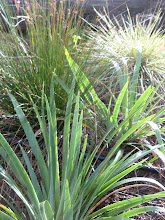I used to go several times a week on this same trail when I was attending Humboldt State University. I've been living nearby off and on for the last couple of years, but when I am staying in the area I go at least once a week. It's not the most impressive redwood forest, since it's a second-growth managed forest, but there are wonderful corners here and there where you can feel lost.
( I have been lost several times in this forest..this is how I originally found the trail.)
Katie is home for the summer and so is our mom's poodle, Annie.


 The Color
The ColorMay is a good time for a hike. I've been impatient, but the Clintonia andrewsiana are finally beginning to bloom. When the flowers dissappear, they'll be replaced by spectacular blue egg-shaped berries. I have Clintonia seedlings growing in a flat at Bayside, but it will be several years before they look like this.



The diversity of flower color in douglas iris is intriguing. My favorites are the pale blue ones, but they also come in deep red-purple, and intermediate shades.



Mimulus dentatus is one of those plants I discovered, propagated, and identified. There's now a nice patch growing in thre creek near the Bayside House. It's similar to M. guttatus the common yellow monkeyflower, but is more graceful and delicate. The leaves are thinner and softer with serrated edges, and the flowers are more trumpet shaped. It also blooms much earlier.
 The Greenery
The Greenery
Blechnum splicant, the common deer fern, is uncommonly cool.
 The spore producing leaves are more skeletal, and they'll turn dark and dry when they go into production
The spore producing leaves are more skeletal, and they'll turn dark and dry when they go into production


Fully back from it's winter rest, is the five-fingered fern, Adiantum pedatum.
 The black wiry stems and leaf ribs were, and perhaps are, the main source of black basketry material for the native peoples of the area.
The black wiry stems and leaf ribs were, and perhaps are, the main source of black basketry material for the native peoples of the area.
 The fresh growth of conifers stand out in the darkness. Here are the new needles of the coastal redwood, Sequoia sempervirens.
The fresh growth of conifers stand out in the darkness. Here are the new needles of the coastal redwood, Sequoia sempervirens.
Flowers of the piggyback plant, Tolmiea menzesii, common houseplant elsewhere, a native forest dweller locally.

















 and some Iris douglasiana, Juncus balticus, J. patens, Deschampsia caespitosa,
and some Iris douglasiana, Juncus balticus, J. patens, Deschampsia caespitosa, 













 Much more subtle are these little spike rushes, Eleocharis pachycarpa.
Much more subtle are these little spike rushes, Eleocharis pachycarpa.




